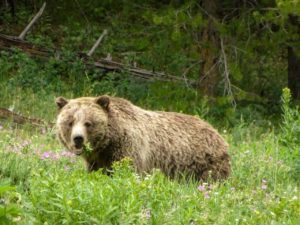
On our first afternoon backpacking in Yellowstone’s Lamar Valley, we saw a grizzly bear. We had just set up camp for the evening in a spruce grotto beside the river when people began animatedly gesturing to ascend the hill that opened up to a small meadow above camp. Upon cresting the hill, it took me a few seconds to notice the shambling brown shape about 100 yards away: a grizzly bear peacefully foraging for grubs and cow parsnip flowers. It looked to be in good health with a full, glossy coat and staggering body mass indicative of its immense power.
The bear was certainly aware of our presence due to our non-subtle exclamations of delight and upwind scent, but it hardly dignified a glance in our direction as it ambled from one cluster of flower heads to the next. For the minutes that it graced us with its presence, we were simply quiet observers, neither party actively engaging with the other. This was the kind of wildlife observation I had been avidly hoping for.
Earlier on in the course we had visited the Grizzly and Wolf Discovery Center in West Yellowstone. As soon as we had entered the facility, I had had to work to conceal my dislike for the place. Their mission statement was to rescue wildlife that would have otherwise died in the wild due to human conflict or parental mortality, but in reality, many of the animals were bred in captivity, giving it the same aura as a zoo. Throngs of tourists were eager to gawk at the captive animals, but I found no appeal in watching the wolves pace restlessly around their small enclosure or a grizzly gnaw disinterestedly at a half-eaten carcass in its shadeless shelter. There was nothing natural about the setting they were trapped in; the animals were merely attractions to be viewed through the anthropocentric lens of commercialism. There was such a disparity between peering in at the captive animals and observing the wild grizzly ponderously peruse the landscape. We were all still gawking at it, yes, but in a respectful manner I’d like to think, and once it had browsed its way across the meadow, the bear was at perfect liberty to lumber away out of our line of sight.
We saw tracks and copious amounts of scat on the trail the next morning, presumably made by the grizzly we had become acquainted with. As we came across pile after pile of notably fresh excrement, I wondered for how long we’d tail this bear and where it was headed. Grizzlies are capable of traveling immense distances and typically require an area of nearly 100 km to range across. At some point, this bear would probably cross the boundaries of Yellowstone and venture south into the Tetons or perhaps cut west into Idaho. This illustrates the importance of corridor ecology with regards to grizzly conservation and the need to connect habitat fragments. For the sake of their genetic health and reproductive prosperity, grizzlies cannot be contained to habitat islands—not even ones as large as Yellowstone—and will always require extensive ranging access. Due to their sizeable habitat requirements, grizzly bears can be described as an umbrella species, meaning that the conservation of their territory will subsequently benefit a variety of other species who inhabit that large area.
Grizzlies are also habitat generalists. Contrary to public perception, the diet of a grizzly is often made up of a variety of vegetative matter and insects, supplemented with meat when the opportunity arises. The scat we observed was full of small seeds and lacking the fur and bone fragments we observed in wolf scat, an obligate carnivore unlike the omnivorous grizzly.
The nature in which we got to observe and connect with the grizzly in the meadow really resonated with me. It ties in with the ideologies of traditional ecological knowledge and how scientific observation does not have to be an anthropogenic quest to extract the unknown bound up in the natural world, but rather a vigil of patient speculation without direct interference. I was privy to a unique interaction that most people do not get to experience within their lifetime: an opportunity to simply observe the beauty of a grizzly bear at peace and decidedly unperturbed in its natural habitat.
Holly Eberhard is a sophomore at the University of California-Davis majoring in Environmental Policy and Conservation Ecology with a minor in Spanish.